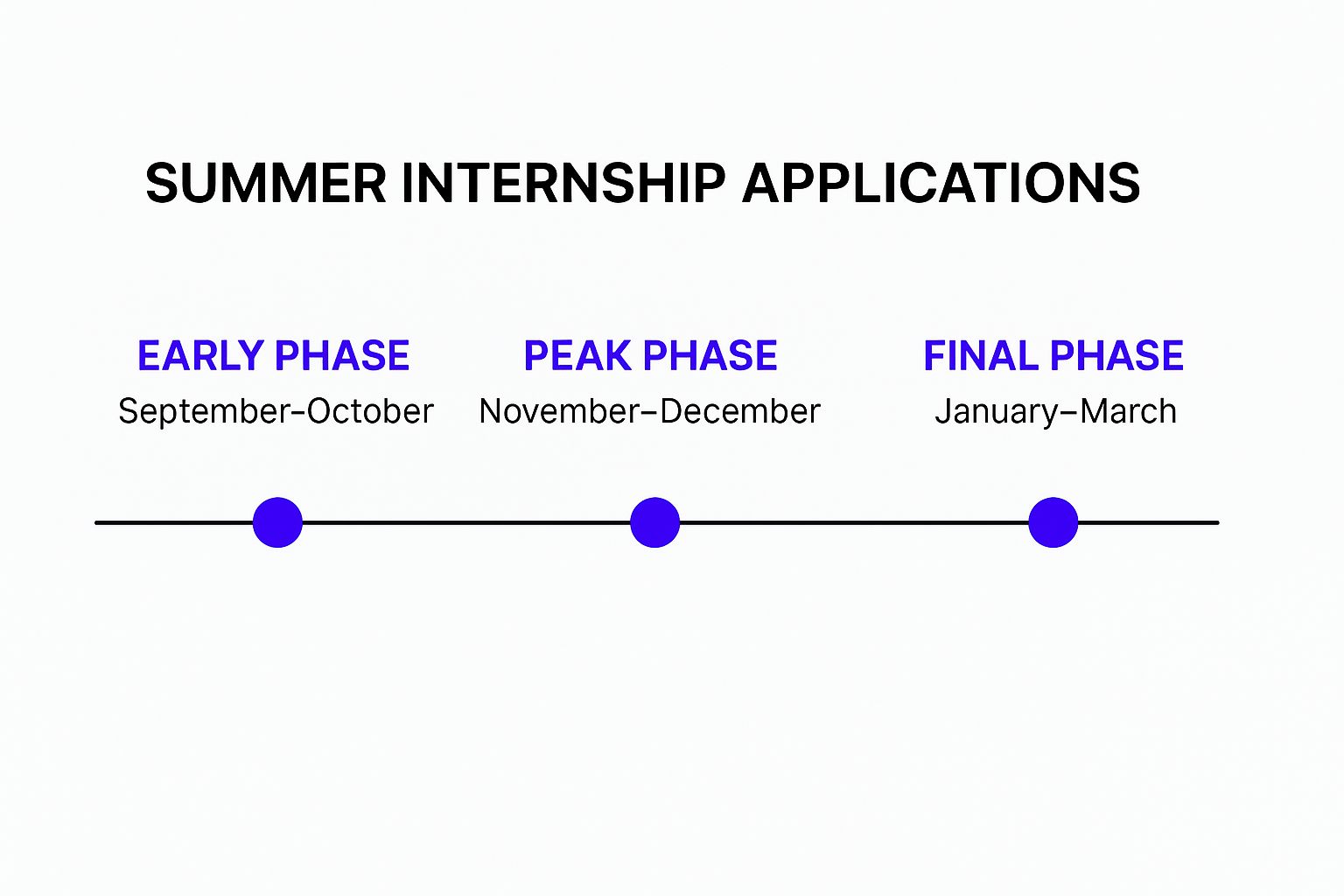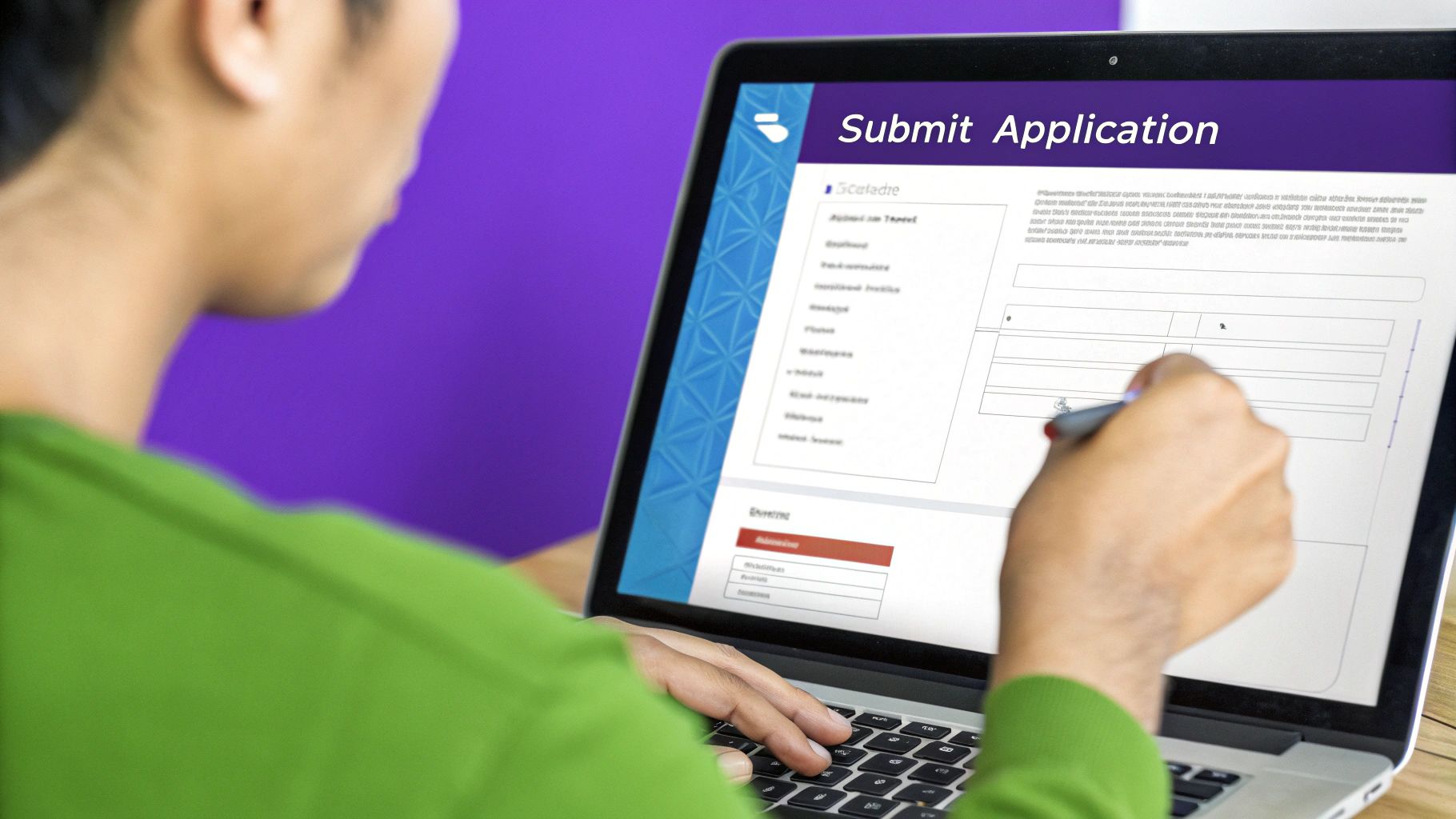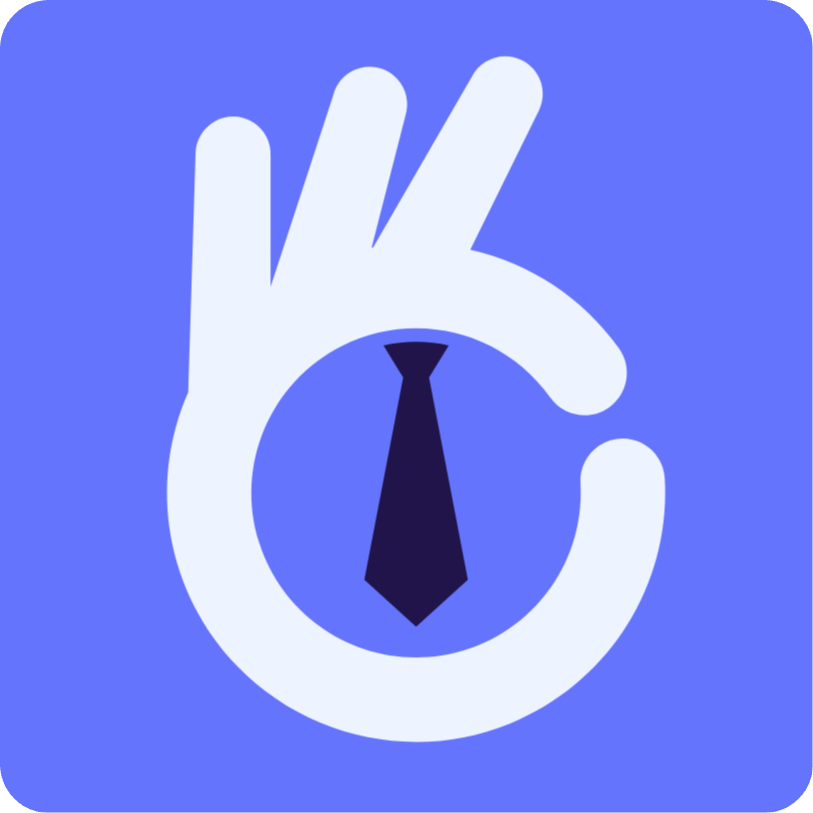When to Apply for Summer Internship A Complete Guide
The single biggest mistake I see students make? Thinking they can start looking for a summer internship in the spring.
The real answer to "when should I apply for a summer internship?" is almost always way earlier than you think. For the most competitive roles, the application window swings open in the late summer or fall of the year before the internship even starts.
Your Summer Internship Application Timeline Starts Now
Landing a great summer internship isn't a last-minute sprint; it's a marathon. You have to shift your mindset and realize the application cycle is a series of phases that kicks off long before you’d expect.
Timing is everything. For many top-tier positions, applications open as early as August the year before. So, if you're eyeing a Summer 2026 internship, your search needs to begin in August 2025. This early start is a massive advantage, especially in cutthroat fields like tech and finance.
To keep your sanity and stay on top of all these different deadlines, grabbing a good job application tracking template is a no-brainer. It’s the easiest way to monitor every opportunity without letting a golden one slip through the cracks.
Visualizing The Application Phases
It helps to see the whole cycle at a glance. This way, you know exactly where to focus your energy and when.

As you can see, that "Early Phase" from September to October is absolutely critical for the big-name companies. The "Peak Phase" is when the bulk of opportunities are posted, but getting a head start gives you a serious edge.
Summer Internship Application Windows by Industry
Here's the tricky part: every industry plays by its own rules. A timeline that works for a tech giant is completely different from a local non-profit.
This table gives you a quick rundown of the typical application periods for summer internships across some of the most popular industries. Use it to help prioritize your search and get your materials ready on time.
| Industry | Application Window Opens | Application Window Closes |
|---|---|---|
| Finance & Investment Banking | August–September | October–December |
| Big Tech & Software Engineering | September–October | December–February |
| Consulting | September–October | November–January |
| Marketing & Communications | November–January | March–April |
| Non-Profit & Government | January–March | April–May |
| Startups | February–April | May (or rolling) |
Remember, these are just general guidelines. Some companies will always be outliers, so the best strategy is to start your research early and keep a close eye on the career pages of your target employers.
Navigating the Peak Application Season

While the finance and big tech giants get a head start in the fall, a massive wave of opportunities floods the market from December through February. This is the peak application season for a huge range of industries, from marketing and communications to startups and smaller tech firms.
So, why this specific window? It often comes down to budget cycles. Many companies finalize their budgets and headcount needs at the end of the calendar year. This gives hiring managers the green light to post their summer internship roles right as the new year begins, turning these months into a total flurry of activity.
Knowing this cycle helps you plan your attack, especially when you're already juggling coursework and final exams.
Prioritizing Your Efforts
During this hectic period, it’s easy to find yourself applying to dozens of roles at once. The real key to success is avoiding application fatigue by focusing on quality over quantity. A targeted approach will always beat a scattershot one.
To manage your time wisely, start by bucketing potential internships into tiers:
- Tier 1: Dream Internships. These are your absolute top choices. Pour your energy here, writing highly customized cover letters and tailoring your resume to perfection for each one.
- Tier 2: Strong Contenders. These are great roles at companies you really admire. Your application should still be well-tailored, but you might not need to rewrite everything from scratch.
- Tier 3: Good Opportunities. These are valuable for getting your foot in the door and gaining experience. Use a strong, adaptable version of your resume and cover letter that you can send out more quickly.
This tiered system ensures your energy is directed where it matters most, which is critical for preventing burnout. Statistically, the December to February window is the best time to apply for summer internships simply because that’s when most companies open their doors. For those finishing their studies, the timeline is quite similar for post-graduate roles.
A well-organized search is a successful search. Trying to remember deadlines, contacts, and application statuses in your head is a recipe for disaster when you're applying to more than five positions.
Thinking strategically about how you approach this season is crucial. Taking the time to build a solid job search strategy before the peak season hits will give you a clear roadmap to follow when things inevitably get crazy. It’s what will help you stay focused and make smart decisions under pressure.
Preparing Your Application Materials Ahead of Time

Knowing the application timeline is a huge advantage, but it’s only half the battle. The other half is being ready to strike the second a killer opportunity pops up. You can't afford to be fumbling with your resume when deadlines are looming.
The secret is to get your materials in order long before the chaos of peak application season begins.
But I'm not talking about creating a one-size-fits-all resume and cover letter. That's a rookie mistake. Instead, your goal is to build an adaptable toolkit. This means having a rock-solid master resume that you can quickly and easily tweak for each specific internship you apply to.
Don’t just list what you did. Show what you achieved. Instead of a flat "Managed social media," try something with punch: "Increased Instagram engagement by 25% over three months by rolling out a new content strategy." See the difference?
Dissecting the Internship Description
The fastest way to get your application tossed is to ignore what the employer is asking for. The real trick to standing out is to speak their language. Before you even think about hitting "apply," you need to break down the internship posting like a detective.
- Hunt for Keywords: What specific skills, software, or qualifications do they keep mentioning? Look for things like "data analysis," "Adobe Creative Suite," or "project management." These are your clues.
- Pinpoint the Core Tasks: What will you actually be doing every day? Make sure your experience section mirrors these responsibilities with concrete examples from your past.
- Spot the 'Nice-to-Haves': This is your chance to really shine. If a posting mentions a preference for public speaking, that's your cue to add a bullet point about that class presentation you nailed.
Once you’ve done this quick analysis, tailoring your documents becomes so much easier. If you want to go deeper on crafting a resume that gets results, check out our guide on how to make your resume better.
Finally, don't sleep on your digital footprint. Your LinkedIn profile should be polished, professional, and up-to-date. Think of it as a living, breathing extension of your resume. A strong profile makes you look credible and can even attract recruiters directly. For an extra edge, you might even explore the future of business headshots with AI-generated LinkedIn profile pictures to make sure that first impression is a powerful one.
Building Connections Before You Apply
https://www.youtube.com/embed/5BesUAyNvFY
Knowing the right time to apply for a summer internship gives you a massive head start. But what really pushes your application to the top of the pile? It's who you know.
A killer resume is great, but a killer resume backed by a warm referral from someone inside the company? That's almost unstoppable. It transforms you from just another name in a digital stack of a thousand applicants into a real person they need to talk to.
This isn't about spamming random people on LinkedIn with generic connection requests. It’s about building genuine relationships before you even think about hitting that "submit" button. And the best place to start is with the resources you already have.
Your university’s alumni network is an absolute goldmine. Seriously. These are people who've walked the same campus paths as you, and most are surprisingly willing to help out a fellow student. A simple, polite email asking for 15 minutes of their time to hear about their career journey can open doors you didn’t even know were there.
Make an Impression That Lasts
Virtual career fairs are another huge opportunity. Don't be the person who just drops a resume link in the chat and bounces. Come prepared with thoughtful questions for the recruiters.
- Ask them about the day-to-day company culture, not just what's on the website.
- Bring up a specific project they worked on that caught your eye.
- Find out what skills they truly value most in their interns.
- Always, always follow up with a thank-you note that mentions something specific from your conversation.
The real goal of an informational interview isn't to beg for an internship—it's to ask for advice. People genuinely love sharing their stories. When you show authentic curiosity, you build a memorable, positive connection that can pay huge dividends down the line.
This kind of proactive relationship-building is a game-changer. If you want a deeper dive, our complete guide on networking for college students breaks down exactly how to do it. Ultimately, the connections you make provide priceless insights and can give you that critical edge when it's time for them to make a decision.
Why a Summer Internship Is a Career Game Changer

Knowing when to apply for a summer internship is one thing, but it’s just as important to understand why you're even doing it. Let's be clear: a great internship is so much more than just a way to fill your summer break. It's one of the single most impactful moves you can make for your career.
Think of it as the ultimate test drive. You finally get to swap the classroom for the real world, taking all that theory you've been learning and putting it into practice on actual projects. This is your chance to figure out if a certain industry—or even a specific role—is the right fit before you go all-in after graduation.
Bridging Theory and Practice
During an internship, you’re not just reading about marketing funnels or coding principles—you’re actually building them. You’ll be a fly on the wall in team meetings, get your hands dirty on live projects, and start to pick up on the unspoken rules of a professional environment.
This kind of experience gives you real stories to tell in future interviews. Your resume suddenly transforms from a list of classes into a portfolio of accomplishments. You'll walk away with skills and insights you just can't get from a textbook, giving you a serious leg up on peers with only academic credentials.
A Direct Path to a Full-Time Job
Maybe the biggest perk of all is how often an internship leads directly to a full-time job offer. Companies aren't just looking for temporary help; they use their intern programs as a primary recruiting pipeline for new talent. They’re investing in you for 10-12 weeks, which is basically one long interview where you get to prove your worth.
An internship is your chance to audition for a company and for the company to audition for you. It's a low-risk, high-reward opportunity for both sides to see if there's a long-term match.
The numbers don't lie. A staggering 74% of interns globally end up with a permanent job offer from the company they interned with. You can see more compelling internship hiring statistics on flair.hr. When you realize the stakes are that high, it’s easy to see why starting early and putting in the effort is so critical. The payoff can define your entire career path.
Still Have Questions About the Internship Timeline? Let's Clear Them Up.
Even with the best-laid plans, things can get confusing. The internship hunt isn't a one-size-fits-all process, and a lot of it comes down to your unique situation. Let's tackle some of the most common questions that pop up.
Is It Too Late to Apply in April or May?
I get this one all the time. While a lot of the big, competitive programs have closed their doors by spring, you are absolutely not out of the game. You just need to change your game plan.
Now's the time to pivot your search toward smaller companies, startups, and even non-profits. Their hiring is often more "just-in-time" as new projects pop up, so they don't follow the rigid fall recruiting cycle. Fire up your network, hit the niche job boards, and don't get discouraged. The pool is smaller, but a killer summer experience is still within reach if you're persistent.
What’s the Deal With Applying to Multiple Roles at the Same Company?
This can be a really smart strategy, but you have to play it right. Many huge companies will have you use a single application where you can rank your top choices—that’s the ideal scenario. But if you have to send in separate applications, make sure every single one is perfectly customized for that role.
Here's where people trip up: they'll apply for completely unrelated jobs, like one in marketing and another in software engineering. To a recruiter, that just looks like you're throwing spaghetti at the wall. A much better approach is to stick to 2-3 closely related positions that show a clear interest in a specific team or department.
How Does This Timeline Change for International Students?
If you're an international student in the U.S., you need to start everything way earlier. I'm talking months. The paperwork for securing work authorization, like CPT or OPT, can add a significant delay to your timeline. You absolutely have to be upfront with recruiters about your visa status from the very first conversation.
Your best bet is to focus on larger, multinational corporations. They already have the legal teams and established processes in place for hiring international talent. To be safe, plan on starting your entire search a full 6 to 9 months before summer to give yourself plenty of buffer room for all the extra steps.
Tired of tracking everything in a messy spreadsheet? Eztrackr is your new command center. It helps you manage every single application in one place with a slick Chrome extension, a kanban board to see your progress, and even AI tools to help polish your resume. See why over 45,000 job seekers use it to get organized at https://eztrackr.app.
 Interview Sidekick
Interview Sidekick